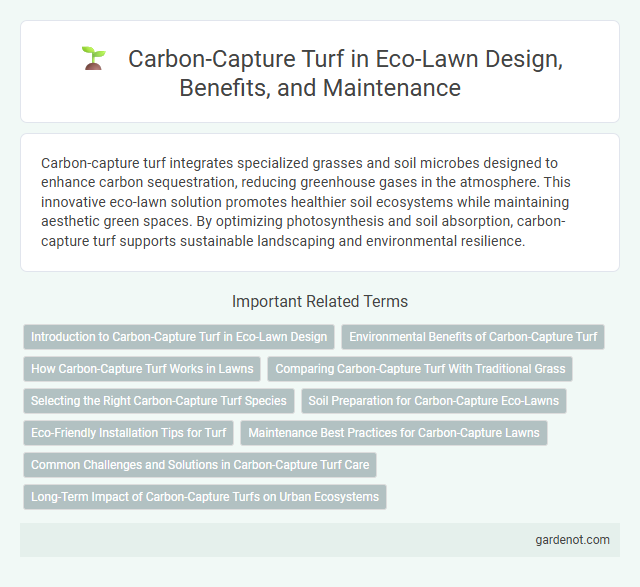Carbon-capture turf integrates specialized grasses and soil microbes designed to enhance carbon sequestration, reducing greenhouse gases in the atmosphere. This innovative eco-lawn solution promotes healthier soil ecosystems while maintaining aesthetic green spaces. By optimizing photosynthesis and soil absorption, carbon-capture turf supports sustainable landscaping and environmental resilience.
Introduction to Carbon-Capture Turf in Eco-Lawn Design
Carbon-capture turf integrates specially selected grass species that maximize photosynthesis to absorb atmospheric CO2 efficiently. Eco-lawn designs prioritize deep-rooted turf varieties, enhancing soil carbon storage and promoting sustainable landscapes. This approach reduces greenhouse gas emissions while maintaining vibrant, low-maintenance green spaces.
Environmental Benefits of Carbon-Capture Turf
Carbon-capture turf significantly reduces atmospheric CO2 by actively sequestering carbon within its dense root systems and soil. This eco-friendly lawn alternative improves soil health, enhances biodiversity, and decreases urban heat island effects through natural cooling. By replacing traditional grass, carbon-capture turf lowers the need for chemical fertilizers and irrigation, further minimizing environmental impact.
How Carbon-Capture Turf Works in Lawns
Carbon-capture turf uses deep-rooted grass species that enhance soil organic carbon levels by sequestering atmospheric CO2 through photosynthesis. These grasses improve soil structure and microbial activity, promoting long-term carbon storage in the soil profile. Maintaining carbon-capture turf reduces greenhouse gas emissions and supports sustainable landscaping practices by transforming lawns into active carbon sinks.
Comparing Carbon-Capture Turf With Traditional Grass
Carbon-capture turf sequesters significantly more CO2 than traditional grass, with studies showing up to 40% higher carbon storage in its root systems. Its dense root network enhances soil organic carbon, promoting long-term carbon retention and improved soil fertility compared to conventional turfgrass. Maintenance of carbon-capture turf requires less mowing and irrigation, reducing overall carbon emissions associated with upkeep.
Selecting the Right Carbon-Capture Turf Species
Selecting the right carbon-capture turf species is essential for maximizing soil carbon sequestration and enhancing overall ecosystem health. Grasses like buffalo grass (Bouteloua dactyloides) and fine fescues (Festuca spp.) demonstrate high carbon uptake rates and resilience to drought conditions. Incorporating deep-rooted varieties improves soil structure and increases long-term carbon storage, contributing significantly to sustainable landscape management.
Soil Preparation for Carbon-Capture Eco-Lawns
Preparing soil for carbon-capture eco-lawns involves enhancing organic matter content and optimizing soil aeration to boost microbial activity critical for carbon sequestration. Incorporating biochar and compost enriches soil structure and nutrient availability, promoting deeper root systems that enhance carbon storage in the soil profile. Proper pH adjustment and avoiding soil compaction maximize turfgrass health and long-term carbon capture efficiency.
Eco-Friendly Installation Tips for Turf
Eco-friendly installation of carbon-capture turf involves using organic soil amendments and ensuring proper soil aeration to enhance microbial activity that supports carbon sequestration. Selecting native or drought-resistant grass species reduces water consumption and maintenance emissions, promoting a sustainable lawn. Minimizing heavy machinery use during installation lowers fossil fuel emissions, aligning turf establishment with eco-conscious landscaping practices.
Maintenance Best Practices for Carbon-Capture Lawns
Carbon-capture turf requires regular aeration and deep watering to promote healthy root growth and maximize carbon sequestration in the soil. Mowing should be done at higher grass heights to enhance photosynthesis and maintain soil moisture, reducing the lawn's carbon footprint. Avoiding synthetic fertilizers and opting for organic compost enriches soil microbes that support carbon capture and improve overall turf resilience.
Common Challenges and Solutions in Carbon-Capture Turf Care
Carbon-capture turf often faces challenges such as soil compaction, uneven growth, and limited drought tolerance, which can reduce its carbon sequestration efficiency. Proper aeration techniques, application of organic mulches, and optimized irrigation schedules enhance turf health while maximizing carbon capture potential. Integrating resilient grass species adapted to local climates further supports sustained carbon storage and turf durability.
Long-Term Impact of Carbon-Capture Turfs on Urban Ecosystems
Carbon-capture turfs significantly enhance urban ecosystem resilience by sequestering substantial amounts of atmospheric carbon dioxide, thereby reducing the urban heat island effect and improving air quality. These innovative turfs promote soil biodiversity and water retention, which strengthen ecosystem services and mitigate the impacts of urban flooding. Over time, the integration of carbon-capturing turf contributes to sustainable urban development by fostering healthier green spaces and supporting climate change mitigation efforts.
Carbon-capture turf Infographic

 gardenot.com
gardenot.com